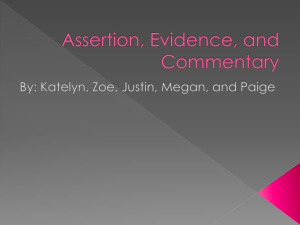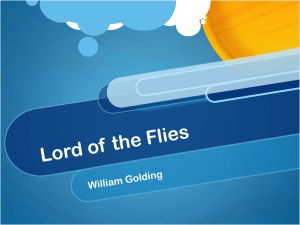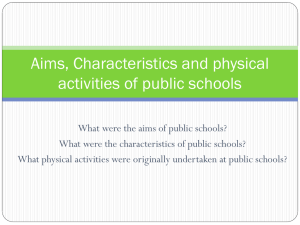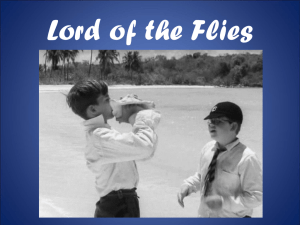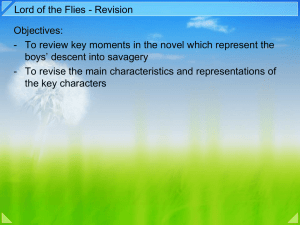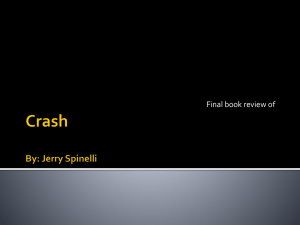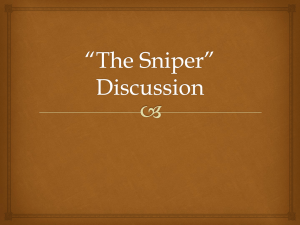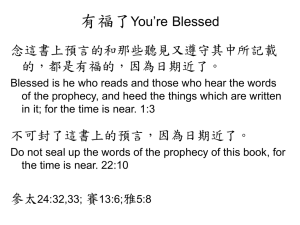Writing a Response to Literature
advertisement
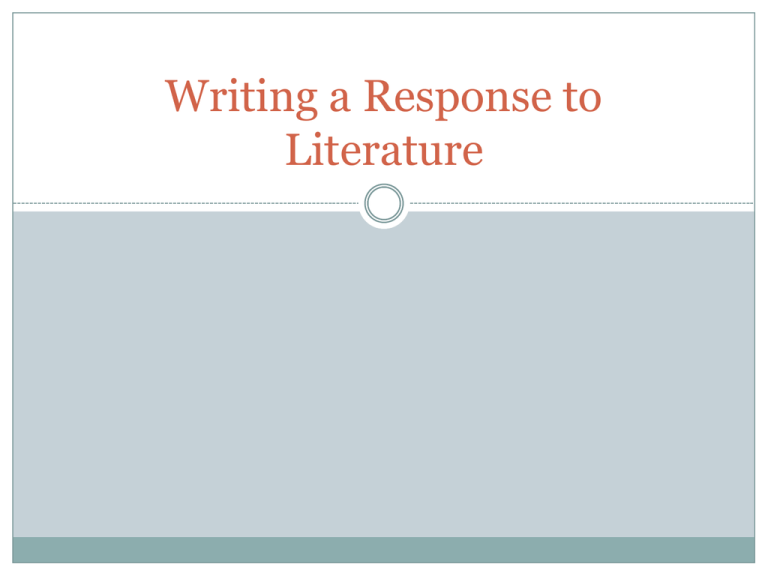
Writing a Response to Literature Bellwork November second: Describe the progress you are making on your LOTF project. What did you get done yesterday? How did you display teamwork and respect for those around you as you worked? Describe your plan for the rest of the project. When you finish, get out a sheet of paper for your quiz Title your page: LOTF Vocabulary Quiz Quiz: Write the definition of these words on your sheet of paper. 1. distended: 2. unquenchable: 3. ensconce: 4. inimical: 5. propitiating: 6. multitudinous: 7. luminous: 8. Myopia: 9. Choose two words to use in complete sentences. Underline the words. A response to lit is… YOUR personal viewpoint of a novel or story. You are responding to a topic presented in your close reading of a novel or story. Defend your thesis with evidence from the text Your RTL essay Let’s read the prompt: You will choose One theme. Three symbols/characters Discuss how the characters/symbols support the theme of the story. Prewriting One Choose the most interesting theme from the list of themes. Make a list/bubble map of events that happen in the novel that relate to the theme you have chosen. Step TWO: Now go back over your list and UNDERLINE characters and symbols that you find in your list. Make a tree map to categorize each event that you listed. Circle the Symbols/characters with the most evidence. Now, you have your theme and your symbols for your RTL essay. The next time we look at our essays, we will talk about the structure for the introductory paragraph. Introduction Outline: Introduction: Attention grabber/Hook Background on the Novel ( 1-3 sentences) Thesis statement Arguable Supportable Original Possible Hooks: 1. an interesting quotation ( related to the theme) 2. an anecdote ( relating to the theme) 3. a rhetorical question ( relating to theme) Background on the Novel 1-3 sentence background on the novel You only need to give enough information so that they can follow you logic later on. Focus on summarizing events in the story that are relevant to your topic. Ex: If my topic is fear of the unknown, then I only want to summarize what the boys are scared of on the island, not every other detail that happens. The Thesis Should follow this format: In the allegorical novel Lord of the Flies, Golding displays the theme _______________ through the characters/symbols _________, __________, __________. Example Introduction As we read the example introduction, look for the major elements that we have just discussed. What’s Next? Begin writing a rough draft of you intro. Homework: Typed Introductory Paragraph due Monday Bellwork November 5th: Today, we will be doing another quick write. The goal of a quick write is to write without stopping for the time allotted to you. Do not worry about grammar or ‘being perfect’ in your writing. Simply, do not take your pen/pencil off of the paper until I say to do so. You may write about anything that comes to mind for the phrase: It was the moment I had dreaded for two weeks. The moment when…. Take out your typed introduction and put it on the corner of your desk for me to check as you write. Body Paragraphs: Get out your notes from last Friday on “Response to Literature Essays” . Add details about body paragraphs to your notes. Topic Sentence Provide the main idea of the paragraph It should be utterly clear what the paragraph is going to be about It should connect to the list you made in your thesis. Subtopic One= Paragraph one Subtopic Two=Paragraph two Subtopic Three=paragraph three In the allegorical novel Lord of the Flies, Golding displays the theme fear of the unknown through the characters and symbols of the beast, Jack, and Ralph. Ex ( paragraph one) : The theme fear of the unknown is clearly displayed through the symbol of the beast. Ex ( paragraph two) : The theme fear of the unknown is clearly displayed through the character of Jack. Ex ( paragraph three) : The theme fear of the unknown is clearly displayed through the character of Ralph. Supporting Evidence Include specific textual evidence: cited quotes from the book Be sure to cite page numbers of the information you use. Do not simply start a sentence with quotes You must always use a transition to lead in a quote Ex: • For example, • In addition, Golding says, He says, Example: The theme fear of the unknown is clearly displayed through the symbol of the beast. For example, the boys have a conversation about the beast at the first assembly saying, “the beastie came in the dark” ( 35). Analysis Explain to the reader the significance of the evidence you have provided. Think about why you chose to include it. How does the piece of evidence support your thesis and answer the question? Example: The theme fear of the unknown is clearly displayed through the symbol of the beast. For example, the boys have a conversation about the beast saying at the first assembly saying, “the beastie came in the dark” ( 35). The boys are scared of the beast because it comes “ in the dark.” The unknown qualities of the beast and how to defeat it drive the fear in the boys as darkness falls each night. Add more evidence and analysis: Each body paragraph should have at least two quotes from the article as support. Each quote should be analyzed in your own words. Example: The theme fear of the unknown is clearly displayed through the symbol of the beast. For example, the boys have a conversation about the beast saying at the first assembly saying, “the beastie came in the dark” ( 35). The boys are scared of the beast because it comes “ in the dark.” The unknown qualities of the beast and how to defeat it drive the fear in the boys as darkness falls each night. The boys are very afraid of the beast as the novel progresses and at one point even say, “There’s nothing in it of course. Just a feeling, but – being hunted, as if something’s behind you all the time in the jungle” (62). Despite admitting that the beast is totally misunderstood, the boys describe a fear of every corner of the immense jungle that surrounds them. They are scared of every part of the island and use the beast as the symbolic representation of this fear of things they do not and cannot understand. Transition Sentence End with a transition sentence to the next subtopic. Connect each paragraph with a sentence or two that demonstrate show each idea leads into the next, and how they work together to support your position. EX: The boys are scared of the beast, but they are also scared of one of their own: Jack. Example: The theme fear of the unknown is clearly displayed through the symbol of the beast. For example, the boys have a conversation about the beast saying at the first assembly saying, “the beastie came in the dark” ( 35). The boys are scared of the beast because it comes “ in the dark.” The unknown qualities of the beast and how to defeat it drive the fear in the boys as darkness falls each night. The boys are very afraid of the beast as the novel progresses and at one point even say, “There’s nothing in it of course. Just a feeling, but – being hunted, as if something’s behind you all the time in the jungle” (62). Despite admitting that the beast is totally misunderstood, the boys describe a fear of every corner of the immense jungle that surrounds them. They are scared of every part of the island and use the beast as the symbolic representation of this fear of things they do not and cannot understand. The boys are afraid of the unknown circumstances of the island and the beast represents that fear; however, the boys are also scared of one another. Example Two: Jack Merridew, when he first arrives on the island, is a prim-and-proper, stereotypical British choir leader: afraid of acting improper, and is very bossy. To make sure that he and his choir boys are aiding in the group’s survival, Jack volunteers himself and his group to be the hunting party. Jack is confident that he will come back to the tribe with food; when the time comes, however, to kill a pig, Jack cannot bring himself to do it, and is unable to “bring home the bacon,” so to speak. When the piglet crosses their path, Jack does not kill it “because of the enormity of the knife descending and cutting into living flesh; because of the unbearable blood” (31). By not killing the piglet, Jack shows how he is afraid to kill, afraid to harm another living creature. As time wears on, however, Jack gives in to his primal instincts, and he and his boys kill with abandon, as evidenced first by the thoughtless murder of Simon, then by the crushing death by a boulder of Piggy. Jack deals with his fear of killing by overcoming it, and giving in to his natural instincts. Body Paragraphs: Topic Sentences Direct evidence from text Analyze quote Support your thesis Use Quotations from text Direct quote from text Analyze quote Transition Sentence Begin writing the rough draft of your body paragraphs now. Typed rough draft of ALL Three paragraphs are due tomorrow! Conclusion Restate your thesis statement Briefly summarize your main points Avoid repeating body paragraphs WOW factor Fear of the unknown is a dominating theme in the novel Lord of the Flies. The symbol of the Beast and the characters Jack, and Ralph display this fear throughout the novel. Golding uses these characters to tell readers that fear should not be a force in our lives that directs decisions. When we are overcome with fear, we act irrationally as Jack and Ralph do throughout the novel. Golding urges readers to dismiss fears that are based in worry about the unknown. Example : Golding uses three boys stranded on an island to illustrate that people facing fear determine their own paths. Jack’s fear of killing is overcome by his primal instincts, Ralph’s denial of his fear of not being rescued is finally recognized, and Piggy’s fear of standing out is overcome by his anger at Jack’s theft of his glasses. Both Jack and Piggy overcome their fears, while Ralph just learns how to accept the existence of his fears. The varied reactions of the three boys lead each of them to different places in their life journeys. Reactions to fear pave the road for future journeys. Other necessary tidbits… Use the present tense when talking about events in the book. Don’t assume the reader has read the book, write a quick, concise summary in the opening paragraph Don’t use “I” statements, weakens your arguments Create an original title Make sure all evidence supports your thesis
